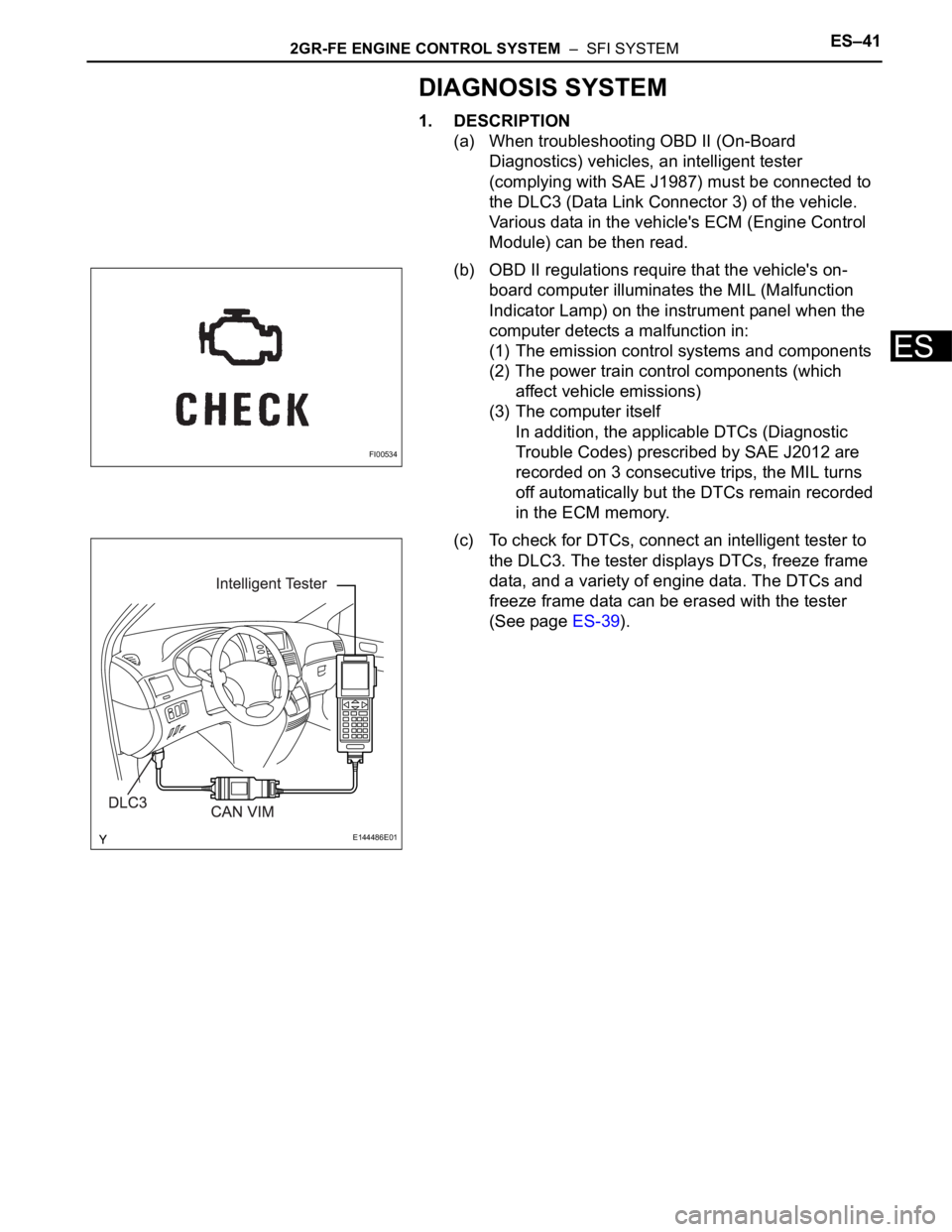Page 804 of 3000

ES–282GR-FE ENGINE CONTROL SYSTEM – SFI SYSTEM
ES
• Vehicle was driven in the city area (or on free-
way) for 10 minutes or more.
(b) Monitor Conditions
(1) Turn the ignition switch off and wait for 6 hours.
HINT:
Do not start the engine until checking Readiness
Monitor status. If the engine is started, the step
described above must be repeated.
(c) Monitor Status
(1) Connect an intelligent tester to the DLC3.
(2) Turn the ignition switch to the ON position.
(3) Turn the tester or scan tool ON.
(4) Check the Readiness Monitor status displayed
on the tester or scan tool.
If the status does not switch to COMPL
(complete), restart the engine, make sure that
the preconditions have been met, and then
perform the Monitor Conditions again.
4. A/F SENSOR AND HO2S MONITORS
(a) Preconditions
The monitor will not run unless:
• 2 minutes or more have elapsed since the engine
was started.
• The Engine Coolant Temperature (ECT) is 75
C
(167
F) or more.
• Cumulative driving time at a vehicle speed of 30
mph (48 km/h) or more exceeds 6 minutes.
• Air-fuel ratio feedback control is performed.
• Fuel-cut control is performed for 8 seconds or
more (for the Rear HO2 Sensor Monitor).
(b) Drive Pattern for front A/F sensor and HO2 sensor.
(1) Connect an intelligent tester to the DLC3.
(2) Turn the ignition switch to the ON position.
(3) Turn the tester ON.
(4) Clear the DTCs.
(5) Start the engine, and warm it up until the ECT
reaches 75
C (167F) or higher.
(6) Drive the vehicle at 38 mph (60 km/h) or more
for at least 10 minutes.
(7) Change the transmission to the 2nd gear.
(8) Accelerate the vehicle to 40 mph (64 km/h) or
more by depressing the accelerator pedal for at
least 10 seconds (Procedure "A").
(9) Soon after performing procedure "A" above,
release the accelerator pedal for at least 4
seconds without depressing the brake pedal, in
order to execute fuel-cut control (Procedure "B").
(10) Allow the vehicle to decelerate until the vehicle
speed declines to less than 6 mph (10 km/h)
(Procedure "C").
(11) Repeat procedures from "A" through "C" above
at least 3 times in one driving cycle.
Page 823 of 3000

2GR-FE ENGINE CONTROL SYSTEM – SFI SYSTEMES–41
ES
DIAGNOSIS SYSTEM
1. DESCRIPTION
(a) When troubleshooting OBD II (On-Board
Diagnostics) vehicles, an intelligent tester
(complying with SAE J1987) must be connected to
the DLC3 (Data Link Connector 3) of the vehicle.
Various data in the vehicle's ECM (Engine Control
Module) can be then read.
(b) OBD II regulations require that the vehicle's on-
board computer illuminates the MIL (Malfunction
Indicator Lamp) on the instrument panel when the
computer detects a malfunction in:
(1) The emission control systems and components
(2) The power train control components (which
affect vehicle emissions)
(3) The computer itself
In addition, the applicable DTCs (Diagnostic
Trouble Codes) prescribed by SAE J2012 are
recorded on 3 consecutive trips, the MIL turns
off automatically but the DTCs remain recorded
in the ECM memory.
(c) To check for DTCs, connect an intelligent tester to
the DLC3. The tester displays DTCs, freeze frame
data, and a variety of engine data. The DTCs and
freeze frame data can be erased with the tester
(See page ES-39).
FI00534
E144486E01
Page 827 of 3000

2GR-FE ENGINE CONTROL SYSTEM – SFI SYSTEMES–45
ES
DTC CHECK / CLEAR
NOTICE:
All the stored DTCs and freeze frame data are erased if:
1) the ECM is changed from normal mode to check mode
or vice versa; or 2) the ignition switch is turned from ON
to ACC or off while in check mode.
Before changing modes, always check and make a note
of any DTCs and freeze frame data.
HINT:
• DTCs which are stored in the ECM can be displayed on an
intelligent tester. An intelligent tester can display current
and pending DTCs.
• Some DTCs are not set if the ECM does not detect the
same malfunction again during the second consecutive
driving cycle. However, such malfunctions, detected on
only one occasion, are stored as pending DTCs.
1. CHECK DTC (Using an intelligent tester)
(a) Connect the intelligent tester to the DLC3.
(b) Turn the ignition switch to the ON position.
(c) Turn the tester ON.
(d) Select the following menu items: DIAGNOSIS /
ENHANCED OBD II / DTC INFO / CURRENT
CODES.
(e) Check for the DTC(s) and freeze frame data, and
then write them down.
(f) Check the details of the DTC(s) (See page ES-56).
2. CLEAR DTC (Using the intelligent tester)
(a) Connect the intelligent tester to the DLC3.
(b) Turn the ignition switch to the ON position.
(c) Turn the tester ON.
(d) Select the following menu items: DIAGNOSIS /
ENHANCED OBD II / DTC INFO / CLEAR CODES.
(e) Press the YES button.
3. CLEAR DTC (Without using an intelligent tester)
(a) Perform either one of the following operations:
(1) Disconnect the negative battery cable for more
than 1 minute.
(2) Remove the EFI No. 1 and ETCS fuses from the
Relay Block (R/B) located inside the engine
compartment for more than 1 minute.
E144486E01
Page 845 of 3000

SLIDING ROOF – SLIDING ROOF SYSTEMRF–3
RF
INITIALIZATION
1. RESET SLIDING ROOF MOTOR
(a) If the AUTO operation function does not operate,
reset the sliding roof motor using any of the
following methods.
(1) Press the sliding roof switch on the TILT UP side
and hold it until the sliding roof motor stops.
Then release the switch and leave it untouched
for 10 seconds or more.
(2) Press the sliding roof switch on the TILT UP side
again for 10 seconds or more and hold it until the
sliding roof stops at the fully open and up
position.
(3) Release the switch, press it again within 5
seconds and hold it until a series of movements
indicated below has done:
Fully closing
Fully opening Fully closing
HINT:
If the battery terminal is disconnected or after
the jam protection function has operated, the
sliding roof ECU may not detect a position of the
roof glass. If the AUTO operation function is still
disabled even if the sliding roof motor has been
reset, the Hall IC (built in the sliding roof motor
assembly) for detecting the roof glass position
may be malfunctioning.
Page 846 of 3000
RF–4SLIDING ROOF – SLIDING ROOF SYSTEM
RF
PROBLEM SYMPTOMS TABLE
SLIDING ROOF SYSTEM
Symptom Suspected area See page
AUTO function does not operate Sliding roof motor assemblyRF-3
Sliding roof system does not operate1. ECU-IG fuse -
2. S/ Roof fuse -
3. IG1 relay -
4. Sliding roof housing assemblyRF-11
5. Sliding roof motor switch assemblyRF-13
6. Sliding roof motor assemblyRF-3
7. Wire harnessRF-3
Sliding roof system stops operation halfway1. Sliding roof motor assemblyRF-3
2. Wire harnessRF-3
3. Sliding roof housing assemblyRF-11
Page 847 of 3000
MP–4MULTIPLEX COMMUNICATION – MULTIPLEX COMMUNICATION SYSTEM
MP
HOW TO PROCEED WITH
TROUBLESHOOTING
HINT:
Troubleshoot in accordance with the procedures on the
following pages.
NEXT
(a) Check for DTCs and make a note of the code that is
output (See page MP-14).
(b) Delete the DTC.
(c) Check if the DTC is output once again when the problem
symptom is simulated based on the noted code.
(1) When no code is output (symptom check and
simulation are possible), proceed to A.
(2) When a code is output, proceed to B.
B
A
(a) Terminals of ECU (See page MP-5)
NEXT
1VEHICLE BROUGHT TO WORKSHOP
2DTC CHECK
Go to step 4
3PERFORM TROUBLESHOOTING ACCORDING TO MALFUNCTION SYMPTOM
4ADJUST, REPAIR OR REPLACE
END
Page 848 of 3000

MULTIPLEX COMMUNICATION – MULTIPLEX COMMUNICATION SYSTEMMP–5
MP
TERMINALS OF ECU
1. MULTIPLEX NETWORK GATEWAY ECU
(a) Disconnect the G4 ECU connector.
(b) Measure the voltage between the specified
terminals on the wire harness side connector.
If the result is not as specified, there may be a
malfunction on the wire harness side.
(c) Measure the resistance between the specified
terminals on the wire harness side connector.
If the result is not as specified, there may be a
malfunction on the wire harness side.
C129903E02
Terminal No.
(Symbols)Wiring Color Terminal Description Condition Specified Condition
G4-1 (IG) - Body ground B-R - Body ground Power supply (IG) Ignition switch: ON 11 to 14 V
G4-2 (ACC) - Body ground P - Body ground Power source (ACC) Ignition switch: ACC 11 to 14 V
G4-10 (BATT) - Body
groundW-L - Body ground Power supply (Battery) Always 11 to 14 V
Terminal No.
(Symbols)Wiring Color Terminal Description Condition Specified Condition
G4-3 (MPD1) - Body
groundR-G - Body ground MPX line Always 10 k
or higher
G4-12 (MPD2) - Body
groundR-L - Body ground MPX line Always 10 k
or higher
G4-24 (GND) - Body
groundW-B - Body ground Ground Always Below 1
Page 849 of 3000
MP–6MULTIPLEX COMMUNICATION – MULTIPLEX COMMUNICATION SYSTEM
MP
2. MULTIPLEX NETWORK BODY ECU
(a) Disconnect the B7 ECU, 1A, 1C, 1E, 1K and 1L
junction block connectors.
B167082E01